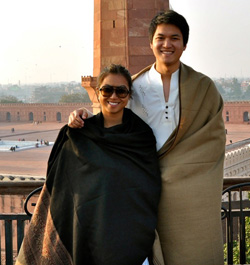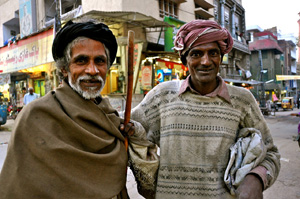By Amy Yu
Hong Kong, China

Amy and brother Steve
at
the Badshahi Mosque
|
I actually saw the airing of Nat Geo’s Don’t Tell My Mother: Delhi the other day from here in Lahore, Pakistan and chuckled to myself. Ironically, I had walked over the border from India into Pakistan, little brother Steve in tow, and had intentionally not informed our mother. Given current geopolitics and the recent Raymond Davis (CIA) case, Pakistan is probably in the top three most dangerous countries for Americans to travel to. Well…surprise, Mom! Your postcard is in the mail.
Lahore, the capital of the Pakistani state of Punjab, holds more than half the country’s population and is known as Pakistan’s cultural capital and as a city of poets. Sitting just 30km from the Wagah border and set along historic and strategic trade routes between the subcontinent and central Asia, the city has suffered a rigorous cycle of “capture, destruction, and rebuild” by, but not limited to, the Mughals, Mongols, Sikhs, and Afghans, and its oldest buildings and monuments boast an exotic mix of cultures as a result.
Pakistan was created in 1947 as an Islamic nation in which more than 96% of the population is Muslim. It claims the world’s 6th largest population, but has nowhere near the same population problems or burgeoning economy as its neighbor India. Instead, Pakistan is unfortunately world-renown, or more likely infamous, for less palatable things such as nuclear proliferation and extreme Islamism, often expressed in the form of suicide bombings, ransom kidnappings, or high-profile jihadi beheadings, to name just a few. Activities that do tend to effectively discourage tourism.
Nearly all backpackers in Lahore stay at a $5/night guesthouse, the Regale Internet Inn, situated down an alley in Regal Chowk. When we arrive, there are only two other travelers. One is a Japanese guy, with a scraggly long beard and hair tied back in a ponytail, who has been traveling for over two years. He’s been at this guesthouse in Lahore for a few months, waiting for the snow to thaw in Kashmir and for the northern border with China to open. The other is a 50-year-old Frenchman with a long grey beard and hair tied back (but also poofed out as if he’s teased it) that unfortunately makes him resemble a Yeti. Both are wearing ugly, telltale, traveler Aladdin pants and cheap Jesus sandals costing no more than $3 USD combined. They also look like they have gone four days without showering. (I find out later that they do wash daily.) They are eating some homemade rice with what looks like thinned-out ketchup sauce when we arrive. Neither looks up at us. So correction: Pakistan knows a very few, hard-core tourists. It was not always like this. The owner of the Inn, Malik, tells us that three years ago the guesthouse would regularly reach full capacity.

Anarkali Bazaar at night
|
American tourism to Pakistan seems to go through cycles generally dependent on security concerns. Gauging by current occupancy, the situation seems to be at a cycle trough. American-Pakistani relations have reached what has been cited an “all-time low” as a result of the Raymond Davis case that unfolded in Lahore. The day before we arrived, Pakistan’s Minister for Minority Affairs Shahbaz Bhatti was gunned-down in central Islamabad after visiting his mother. A few days before, seven oil tankers blew up on the outskirts of Peshawar. A day after we arrived, a bomb at a mosque in Peshawar killed scores of people. The Taliban claimed responsibility for most, if not all, of these. Every couple days, something or somebody blows up in Pakistan.
But as they say, a lack of tourists is also your gain once you actually make it to the destination. Sure, there aren’t as many facilities around for you to use, and the guidebooks aren’t as comprehensive. The recommendations are very curious and the maps have changed since the last edition ten years ago. But there are things to see in Pakistan - beautiful things - and once you adjust to the lack of a developed tourist market, you really see just how much better it is. Peoples’ eyes light up when you speak to them. They have a curiosity in who you are and why you are there. They pull their families over to meet you and invite you to sit down to have ice cream or cookies or tea with them. Prices are not yet tourist-inflated and you pay exactly what the Pakistani man next to you pays for that plate of dhal or that ice cream cone. Rickshaw drivers don’t try to rip you off and when they decide to have a crack at it, they don’t really know what to quote and all too easily compromise on your terms. People point out every big store and hotel, every monument and sight passed when driving, turning around to eagerly explain what it is and why it’s important to them. They get excited when you sit down in their restaurants; they fight over who can attempt to serve you in English. They go to all ends to find you that mineral water, that fork or that toilet paper. Now that they have a chance at a tourist, they do their most to afford you the best experience of their country, and genuinely want to dispel the negative portrayals we get overseas. They are just so excited and so grateful for your interest. It is extremely humbling.
I admit when I first arrived, it was also extremely intimidating as a foreign woman to walk down some streets where women barely make an appearance. I’ve been in male-dominated Muslim countries before, by myself, and yet I still find Pakistan to be more uncomfortable even though I am accompanied by my brother. My guess - the added security concerns.
For instance, although Syria was technically on America’s “Axis of Evil” list and conjures up a fairly dangerous picture in most American minds, Pakistan, with its homegrown Taliban and past beheadings of American nationals, poses a very different type of danger. That said, a couple days later we find ourselves comfortably visiting our favorite stores in Anarkali bazaar, returning to our new favorite restaurants around the chowk and Old City, knowing how to walk from A to B and how much it should cost in a rickshaw. We do make some adjustments; for one, we buy some local garb, called shalwar kameez, which basically constitutes a long cloth tunic to your knees over loose cloth pants. And though we have hoodies, we switch over to the large wrap shawls that everybody uses (now a huge fan - converted) to keep warm at night. Most importantly, we never tell anybody we are American and instead say we are Chinese, which really gets the crowds going. “Oh, Pakistan and China good friends!” which is true. Similar to the attention China has been pouring on African nations, it has helped Pakistan by facilitating business and constructing the famous Karakorum Highway. And they love us. So the lesson here is: pretend to be Chinese.

In Heera Mandi (Red Light District)
|
Pakistan does have its own specific dangers and I won’t try to downplay them here or anywhere else. Taliban was born here. Taliban does breed here. Taliban is trained here. And, Taliban is active and kicking. Nobody will deny this. What you have to realize though is that Taliban presence and danger greatly vary from province to province. Lahore, being in Punjab, is known to be the most insulated from Taliban activity. While there have been bombings as recent as this year, they are few and far between when compared to activity in any of the other provinces (though the governor of Punjab, Salman Taseer, was assassinated in January by a member of his own security detail). Karachi is dangerous as it always has been, Quetta as well, and so on and so on. Peshawar is very dangerous (the Pakistani Consulate wouldn’t grant my visa until I told him I would not visit Peshawar) as the capital of the northwest frontier province bordering Afghanistan - the birthplace and beating heart of Taliban activity. It is also important to note though that foreigner kidnappings are not as common anymore and the Taliban now concentrate much of its efforts targeting the Pakistani army and police forces. The Taliban are also known to target mosques of certain religious sects, special event gatherings at these places and crowded areas, such as markets and bazaars. They also seem to have a penchant for the 5-star hotels where politicians and foreigners tend to stay. Once you know the usual bomb targets, you can significantly manage your risk. This may sounds a little crazy and on the intense side, but the key is to stay informed and aware of developments and to be especially cautious when you are out at night.
One of my main reasons for this adventure into Pakistan, and frankly any country on the more unappetizing end of the spectrum, is just plain curiosity. Is it really as dangerous as they tell us? Is it really how the movies, the books, the newspapers make it out to be? Are they really that backward, that hostile, that different? Rarely, if ever, do I find that our western media portrays these countries fairly. I prefer to see for myself and find those beautiful parts that so few have the privilege or faith to find. And I have found that Pakistan is lovely, interesting, delicious, warm, colorful, and full of history and importance. I admit that I didn’t expect this of Pakistan, but then again I really didn’t know what to expect - and there is something beautiful in that.

